















in the foothills of the Ozark Mountains in Missouri, High Adventure Ranch offers all of the excitement of western big game hunting without the costs and hassles.


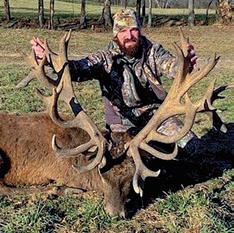






Be prepared for a fair chase hunt! With over 3 square miles of prime natural habitat, our ranch provides challenges to even the most seasoned hunter, but our expe rienced guides and “No Game, No Pay” policy practically ensure that you won’t go home empty handed. In addi tion, High Adventure’s hunting season is year-round, allowing ample time to fit the most demanding schedule.
While our whitetail, elk, wild boar and red stag hunts top our hunter’s most popular lists, hunters from around the world have visited our ranch, hunting everything from American bison, black buck, fallow deer to Spanish goats and African game.
So, whether you desire a 10-point whitetail mount for your trophy room or simply the thrill and challenge of taking down one of our many elusive big game animals, High Adventure Ranch guarantees memories of an unparalleled hunting experience that will bring you back again and again.



















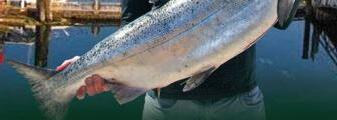
























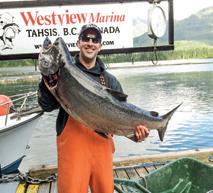

















While the spring season is the most attractive for California turkey hunters, why not get out during the fall season – the opener is Nov. 12 – and score a wild bird for your Thanksgiving holiday meal? Our Cal Kellogg likes the challenge of an autumn hunt and shares some of his ideas for how to fill your tag and avoid the grocery store for your Turkey Day main course.
When it comes to duck hunting, you live and die by your decoys. Knowing how to place your spread and – more importantly – rearranging their placement in response to changing weather, wind and/or bird behavior can go a long way toward limiting out. Scott Haugen has you covered with this strategic tutorial, while Tiffany Haugen stirs up a Koreanspice-infused game bird recipe in their From Field to Fire feature.
San Diego’s Mission Bay is one of the most productive saltwater fisheries in the Southland and it can provide a freshwater-style bass fishing experience too. Capt. Bill Schaefer knows how to fish these waters as well as anyone, and he provides the tactics and baits that can tempt spotted bay bass and other species.









It was toward the end of high school in the mid-1980s when I started to wonder what I wanted to do with my life. That’s typical at that age, and second only to my prized Atari game – I was a Defender and Space Invaders nerd – was my school’s career center computer.
I don’t remember much about the computer’s technology, but I know we could periodically come in, request information about careers and the printer would spit out a bunch of content about specific vocations. I was so obsessed with fishing and the outdoors I chose to get feedback about “fish and wildlife specialists.” I remember being excited about the description of what these professionals do, and less enthused when, at the time, jobs were scarce and hard to come by.
I settled for combining my love for writing and sports and studied journalism at college enroute to that field, but I always wonder what might have been if I had followed through on my first passion.


I was reminded of my choice while
fishing with fellow Bay Area resident Don Franklin (page 67), who’s been a charter fishing boat captain out of San Francisco since the early 2000s. Though Franklin, an Oakland native, has also been working for the San Francisco Recreation and Park Department since attending San Francisco State, I asked him if he too always had a desire to make a living in the fishing industry.

“For me, it was a thing where I used to go out on charter boats with my dad. And eventually it came full circle in that not only were the guys I knew and went out on their boats, I became a peer and a coworker of them once I got my own boat. So it was like all the guys I grew up idolizing, now I’m working with them.”




But it was more preordained than that, something that really hit home during one of his recent birthdays.
“My mom gave me a picture that I had made in like the first grade. And it was me on a boat in San Francisco, and I had (drawn) the Golden Gate Bridge,” Franklin says.


“I asked, ‘Where did you get this?’ She saved it. She asked me, ‘How did you know what you wanted to do what you (now) do?’ And I said, ‘I don’t know how. I was just meant to do it.’”


In getting to know Don, both that day on the boat and in a phone chat we had a few days later, I learned we had baseball in common as youngsters in the Bay Area. We both rooted for the Oakland A’s and some of the elite baseball talent his city produced – though Franklin admitted he was also a huge fan of the great Willie McCovey of the rival San Francisco Giants –and we ultimately got involved in sports (I write about them; he coaches kids as part of his job with parks and rec).
But I commended Don’s commitment to living out his dream he drew on that piece of paper so many years ago. I guess in some ways these years I’ve spent at California Sportsman at least have given me a taste of what I could have become. I’m just grateful I can share Capt. Franklin’s story. -Chris Cocoles












I caught this nice pre-tournament largemouth before Mohave was closed. This year was the U.S. Open’s 40th anniversary edition. It’s usually held on Lake Mead, but was moved downstream due to low water levels. (TODD KLINE)










We’re not ashamed to admit it: Todd Kline has the kind of life we wish we could experience. Kline’s a former professional surfer, a successful co-angler on the FLW Tour and a Southern California bass guide, plus he gets to travel the world as a commentator for the World Surf League’s telecasts. Todd has agreed to give us a peek on what he’s up to each month. For more on Todd or to book a guided fishing trip with him, check out toddklinefishing.com, and you can follow him on Instagram at @toddokrine. –The Editor
In the end I managed a 10th-place finish! I weighed in 46.89 poiunds of bass during the two-day event. (TODD KLINE)

This was a great year, one with consistent tournament results. I was able to win the Angler of The Year title. (TODD KLINE)

More adventures with me and my donkey friends. (TODD KLINE)


An afternoon monsoon is part of the desert experience. (TODD KLINE)
Here’s a big smallmouth to send us into November. Happy Thanksgiving! (TODD KLINE)






For your shot at winning a Coast knife and light, send your photos and pertinent (who, what, when, where) details to ccocoles@media-inc.com or California Sportsman, 941 Powell Ave SW, Suite 120, Renton, WA 98057. By sending us photos, you affirm you have the right to distribute them for our print or Internet publications.


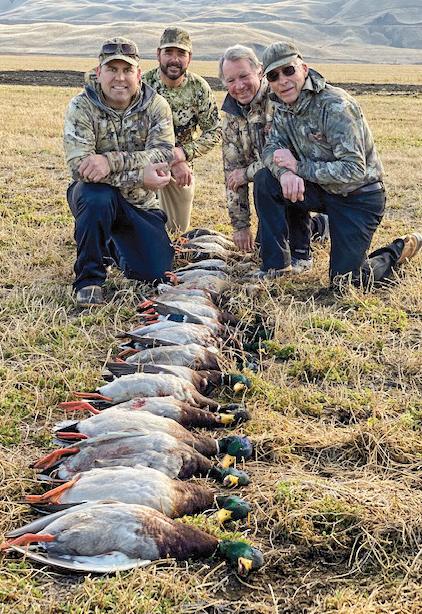



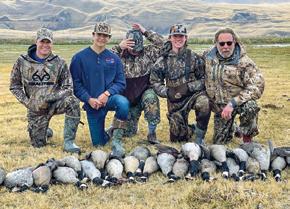







Calling in a big beautiful gobbler like this during the spring is certainly a thrill, but author Cal Kellogg asserts that fall hunting is more challenging than the spring if your goal is consistent success. (CAL KELLOGG)
Here in California, we are blessed with both fall and spring turkey seasons. The spring season claims most of the

excitement among hunters. The fall season is an “also ran” of sorts.
Spring gobbler hunting offers a lot of glitz and excitement. It comes at the end of a long, drab winter, when the woods are green and full of life.
Hunters decked out in the latest camo run from ridge to ridge, hammering with a crow call here and ripping off yelps on a friction call there.
If all goes right, you locate a big bad gobbler with a long black beard and

Istarted hiking about 30 minutes be fore daybreak. By the time I reached the gully I could see the milky glow of dawn in the eastern sky. I turned up hill, left the old logging road, walked about 30 yards, cleared a spot to sit be neath a mature oak tree and settled in for what might be a long wait.
Considering it was November, it was chilly but not cold; it promised to be a perfect fall day for hunting turkeys, with blue skies and little wind.
I retrieved a box call and a mouth call from the chest pack. I set the box to
my left, slipped the diaphragm into my mouth, slid down the face mask and laid the Remington 12-gauge across my legs.
When songbirds started sounding off, I scratched off a few sleepy yelps on the box and listened. At first, I only heard woodpeckers and blue jays. Several min utes passed before I heard some faint yelps in the distance. I was in business!
I’d been aware that there were turkeys in the drainage for a couple months. I hadn’t actually seen them, but I’d heard them, and I’d seen their tracks on multi ple occasions. They had been traveling
down the old two-track road. At times they moved single file. At other times the tracks spread out, apparently when the birds slowed down to feed.
I based the ambush on the tracks. The problem was I had no idea what time of day the turkeys were walking the road. Was it at dawn, midmorn ing or early afternoon? Hearing those yelps confirmed there were turkeys in the area and hardened my resolve to stay put under the oak until the birds showed or until shooting time ended at 4 p.m. If I were hunting a spring gobbler, I’d try to simulate the sound of hens flying off the roost, but the fall season is different.
Periodically I’d make a few light yelps and scratch in the fallen leaves a bit. Rather than trying to call in the turkeys, I was just using turkey sounds to put the birds at ease.

Minutes turned into an hour. I’d seen a pair of does ghost by, but I hadn’t detected any turkeys. Things changed around 10 when I heard some rustling behind and below my position.
There would be periods of quiet and then more rustling. I was contemplating if it was the deer I’d seen earlier or the turkeys when I caught a flash of move ment out of the corner of my left eye.
It was the turkeys, and they were walking right down the road like I hoped they would. Ever so slowly they came into view. I was expecting a group of hens. Instead, it was a string of seven jakes.
With the gun laying across my thighs, I’d have to scoop it up to my shoulder and shoot in one fluid motion since they were sure to see the move ment. I waited until the lead bird moved well past my position and then made my move. They saw me but didn’t spook immediately; that was a mistake.
author’s prehunt scouting and a solid ambush strategy converted this tender fall jake into a fond memory and several outstanding meals. (CAL KELLOGG)
The third jake in line was about 40 yards away. When the red fiber optic front sight covered his head, the shot gun went off and chaos ensued. Some birds flew and some ran, but not tur key number three. Instead, he flipped, flopped and flapped on the far side of the two-track – dead on impact. The heavy payload of tungsten shot had done flawless work! CK


an iridescent red head, call him into handshaking range and close the deal. The rest is all back slaps, photos and turkey for lunch and dinner for a week!
But the fall season, while not as glamorous as spring hunting, offers unique challenges and rewards for the hardcore turkey enthusiast. As a lifelong and consistently successful public land turkey hunter, I’m going to tell you straight away that fall hunting is tougher than spring hunting, even though you can harvest birds of both sexes. Why?



First, while fall turkeys can be called to some degree, calling isn’t a key component of a successful hunt this time of year. Second, fall turkeys tend to move around in groups. Turkeys are wary and there is safety in numbers. Think you have to sit still to elude the sharp eyes of a spring gobbler? The challenge of remaining undetected increases exponentially when you are dealing with the keen senses of five or 10 or 20 turkeys traveling as a group!










Successful fall turkey hunting depends on good old-fashioned woodsmanship and scouting. The first thing you need
to do is locate areas that hold turkeys. In 2022, the general fall season kicks off on November 12, but your scouting should have begun well in advance. August and September are prime times for scouting. This might seem too early to pin down a bird for November, but it’s not. In fact, early scouting offers a distinct advantage.

Turkeys must drink at least once per day and prefer to drink twice, once
after leaving the roost and again before turning in for the night. Most parts of Northern and Central California are arid during the late summer and early fall. Find water, and if there are turkeys around, they will be nearby.
By November it may well be raining with water more widespread, but apart from the spring breeding season, turkeys tend to be homebodies. They form groups and



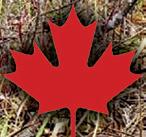




are reluctant to leave their home range unless they must. Deep snow that lingers or heavy pressure will cause them to move, but most of the time turkeys you locate in September will be in the same general area when the fall season kicks off.
For maximum fall success you’ll want to locate more than one group of turkeys. This gives you options once the season opens. Finding birds in the late summer and early fall can take time and boot leather. First identify yearround water sources in turkey country and then spend some time either at dawn or just before dusk listening for turkey sounds from the ridges above the streams. At times you might hear a gobble or two, but most of the time you’ll hear clucks and yelps.
When your listening posts pay off, make a mental note of the location of the roost. The next step is to move in and try to identify sign in the form of tracks, droppings or areas where the birds have been scratching

and feeding. The presence of a dirt road makes finding tracks an easy proposition if birds are in the vicinity.
Once you locate some signs, try to piece together the general direction of the turkey’s travel and, if possible, keep track of what the birds are feeding on. Since you’re scouting early, you’ll want to drop in on the birds occasionally to keep tabs on them and stay informed as to their movements.
It’s possible to glass for turkeys successfully in open country. Most of the terrain I hunt features thick vegetation, so I’m restricted to listening for birds and hiking to locate ground sign.
Conventional wisdom dictates the best way to hunt fall turkeys is to locate a flock, run into their midst to scatter the birds, then set up and call them back in. The idea is that turkeys are so eager to flock up that they will move toward turkey sounds once
they’ve been scattered.
This strategy may work great; I don’t know because I’ve never been in a position to try it. If the season is open and I’m close enough to a group of birds to run into the flock and spook them, why wouldn’t I just pick out a nice plump hen and take the shot?

For me, ambush hunting and spotand-stalk hunting have been the most effective approaches for harvesting fall turkeys. It takes time and effort to pattern a flock’s movements, but once you do the chances of ambushing them is very good. The fact that you have the luxury of sitting and waiting in a camouflaged position negates the turkey’s two most important senses for sensing danger: their keen vision and sense of hearing.
When I’m sitting on a stand, I like to incorporate a little calling into the game in the form of light clucks and yelps, just to put any approaching birds at ease. But when it comes to calling, don’t overdo it. Zero calling is


better than calling too much.
If a general area is holding birds but you can’t pattern them, spot-andstalk hunting is an option, but you’ve got to bring your A game. You must move very slowly and avoid making any noise.
Binoculars are an important tool for this work even in thick country, since it’s critical that you see the turkeys before they see you. If the birds are within range when you see them, it’s game on. Move fast, pick your target and take your shot.
If the turkeys are out of range, freeze and evaluate what they are doing. If you stay put, will they move into range? If not, watch them and

Turkeys of either sex are legal during the fall season. If you get lucky you might find a bachelor group of gobblers and harvest a big heavy tom like this. Shots also can be longer than those typically taken in the spring, so it’s important to know your gun and choose a load that allows you to reach out at least 45 yards. (CAL KELLOGG)
plan your next move. If you know the country, you might be able to let them move out of sight and then move quickly to cut them off or ambush them as they move through the woods.
One time I spooked a flock of about 40 hens. They took off running, but I had a pretty good idea where they were headed. I took off at a sprint to cut them off, and when I reached the spot I figured they’d push through, I just dropped to my knees behind an uprooted pine tree when the first bird trotted into the opening. The first few made it past as I gathered myself, but when a big mature hen stopped about 35 yards away, dinner was served!
Fall hunting often requires longer shots than spring hunting and at times you’ll be shooting at spooked birds that are on the move. For this reason, it’s important to know your gun. I wouldn’t be comfortable with a fall turkey rig that doesn’t allow me to reach out to the 45- or 50-yard mark with confidence.


I’ve been shooting the same pump Remington for 25 years, simply because I know how it shoots. I loved the old Remington copper-plated lead turkey loads. When the state outlawed lead, I learned my shotgun loves 2-ounce payloads of tungsten even better.
The load I’m using now makes use of No. 5, 6 and 7 shots, and it hits like Thor’s hammer. Those loads paired with an old Dead Coyote vented choke have killed birds out to 55 yards for me. That’s a long, long way out in the turkey woods. But sometimes you’ve got to go long or go without a wild turkey on the Thanksgiving table! CS
Editor’s note: Cal Kellogg is a longtime Northern California outdoors writer. Subscribe to his YouTube channel Fish Hunt Shoot Productions at youtube.com/ user/KelloggOutdoors.
North American Ammunition Company was founded in 2019 with a focus on hunting big game animals. We introduced our first offering in December of 2019 and have continued to add cartridges ever since. We use top of the line gear and components to produce consistent, premium individually loaded ammunition for your next hunting adventure. Our direct to customer business model allows us to offer custom and semi-custom ammunition, our own house recipes, and reloading services. We produce custom ammunition to fit your needs.






FROM FIELD...

When ducks are flaring from your spread, don’t hesitate to make changes. A simple adjustment can mean the difference between a great day or a dismal one. (SCOTT HAUGEN)
 By Scott Haugen
By Scott Haugen
Duck season is here, and if you really want to see how effective your decoy spread is, don’t shoot at every incoming bird. Easy, right?
Late last season, one of the flooded fields I hunt was saturated with wigeon. Scouting led me to estimate at least 3,000 wigeon were using the pond and grazing on the fresh green grass around it each day. Included in the count were four Eurasian wigeon – three beautiful
drakes and an appealing hen.
On a morning when the wind was finally right – I could prop up my little homemade panel blind with a rising sun at my back – I headed out with one of my dogs. I vowed not to shoot until noon, unless a Euro drake came in. At 11:55 a.m I couldn’t take it anymore and fired my first volley, dropping two drake wigeons as they backpedalled into the decoys.
By the time I pulled the trigger that morning, over 700 ducks –mostly wigeon with a mix of greenwinged teal and pintails – had landed

in the decoys. I quit counting at 700 and shot shortly thereafter. I didn’t see a single Euro drake until late in the afternoon when one circled wide but didn’t come into range.
But what I learnedon that morning was eye-opening. I started with 12 floating wigeon decoys and a dozen silhouettes placed in a few inches of water near my blind.
The floaters were in a U shape and I figured the ducks would land in the middle of it. They didn’t. In fact, they banked and landed on the points and outside edges of the U.
Tiffany Haugen uses gochujang, a Korean chili paste, to add flavor to game birds and create a

Most upland game birds have a mild flavor profile. Unlike waterfowl, their level of gam iness is not usually affected by what they are eating. Instead of worrying about neutralizing the wildness of upland game birds, many cooks look to amp up the fla vor a notch.
If you’re a flavor junkie, one ingredient that is a must-have pantry item is gochu jang. This fermented Korean red chili paste isn’t overly spicy, but it’s full of umami sa voriness. Gochujang can be found in the Asian section of many grocery stores and can be used in marinades, sauces, stews and stir-fries.
¾ to 1 pound boneless game bird meat (breasts, thighs, legs)
2 tablespoons gochujang
2 tablespoons soy sauce
2 tablespoons orange juice
2 tablespoons sesame seeds
1 tablespoon minced jalapeño pepper
1 tablespoon sesame oil
1 tablespoon rice vinegar
½ inch grated fresh ginger
¼ cup chopped green onion or chives
1 tablespoon olive or coconut oil
Corn or flour tortillas

Lemon or lime wedge for garnish Top with desired salad greens or herbs
Clean game birds and remove meat from bones. Cut meat into small strips. In a small bowl mix gochujang, soy sauce, orange juice, sesame seeds, jalapeños, sesame oil, vinegar, ginger, and green onions or chives until thoroughly combined. Add meat to gochujang mixture and stir until meat is coated. Refrigerate and marinate two to eight hours. Let meat sit at room temperature 20 minutes before pan frying.
Heat olive or coconut oil in a large skil let on medium-high heat. Add all meat and marinade to the pan. Pan fry eight to 10 minutes stirring constantly. Serve on a tortilla with desired toppings.
Even though upland birds are flavored mildly compared to waterfowl, be sure to take proper care of them in the field, espe cially on warm days. Doing so will optimize their quality and overall flavor.
Be sure to draw the birds and get them cooling as quickly as possible. When butchering, make sure to remove all feathers and bloodshot and clean all wound channel.
Editor’s note: For signed cop ies of Tiffany Haugen's best selling book, Cooking Game Birds, visit scotthaugen.com for this and other titles.



So I opened up the U and created two parallel lines of decoys: five in one line near the narrow end of the pond, plus seven in the outer, wider line.
I couldn’t keep the ducks out of the gap in the center. They loved the open pathway and 15 yards from my blind a couple hundred landed smack in the middle of it.
Then the wind shifted and birds circled wide to the east. After I set out four dozen more Big Al’s silhouette wigeon decoys, instantly the ducks started landing in the pockets. In fact, every pocket I created with the silhouettes had ducks land in them – both on land and in the water –including some dandy drake pintails.
I left that afternoon having learned a lot about adjusting decoys based on wind changes and duck behavior, things I wouldn’t have learned had I been quick to pull the trigger. I went home with a limit of drake wigeon; all had green heads.
Two days later a buddy and I were back out there, and the morning started off just as the hunt prior. The only difference: my friend couldn’t take it. In less than 20 minutes he had a limit. Then he had to sit and wait for me; that’s when he learned to watch ducks really work a spread.

ON ANOTHER HUNT LAST season my 81-year-old dad and I agreed not to shoot unless ducks were backpedaling into the decoys. Early on we had multiple ducks landing on the outside edge of our spread, which was about 40 yards away.
It was further than we wanted to shoot, as the birds simply weren’t coming in tight to the spread. Dad suggested we take down our windpowered spinning decoys – three of them, to be exact. We did and opened up a couple landing lanes in the middle of the spread. In less than two hours we had our limits, firing a total of 18 shots; every bird dropped
in the decoys.
During a solo hunt last season, I’d patterned ducks landing on the west end of a pond. Before daylight I was set up, but no birds came in. Instead, they landed in the middle of the narrow pond, in a place I could wade to. So, I relocated my decoys and one-man blind. Birds kept coming, but now they landed on the eastern edge of the pond. I moved again.


By this time the sun was in my eyes and ducks were flaring, so I moved the blind across the pond. I rearranged my dozen floater decoys to the west of me and spaced them widely for ducks to land amongst. Then I took my half-dozen life-size mallard decoys, put them tight to my blind on shore and put four dozen Big Al’s silhouettes in a tight line to the east of me along the shore. The scene of feeding and roosting ducks did the trick, and soon I had a stud sprig, two greenheads and a mix of wigeon to show for it.


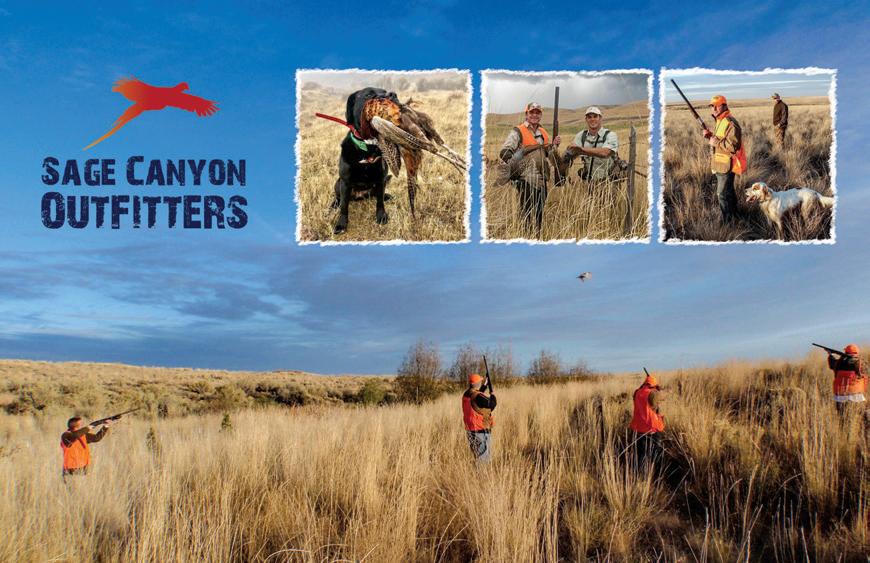




If you want to see how well your decoy spread performs, let birds work them before pulling the trigger. Echo the dog happily will return your prize. (SCOTT HAUGEN)


IF YOU REALLY WANT to see how effective your decoys are, refrain from pulling the trigger at the start of the hunt. Watch closely how approaching ducks respond to your spread. If they don’t work and land exactly where you want them to or prematurely flare, change something. Don’t wait. Once you notice birds hesitating, make an immediate adjustment.
What you’ll learn is that numbers, sizes, shapes, styles – even colors and species of decoys – can impact the outcome. As my dad says, “Decoys are meant to shoot ducks over,” not as they pass by or swing wide. For me, that’s the joy of duck hunting: watching birds work a strategically situated decoy spread. CS
Editor’s note: Scott Haugen is a waterfowl hunter of 47 years and a full-time writer for the past 21 years. Learn more at scotthaugen. com and follow him on Instagram.












November is finally here, and with it, loads of bird hunting. For many of us, our season started in September with grouse, quail, doves and pigeons. For others, it began with early-season waterfowl hunts, up north.
If you were out on some of those early hunts, you’ve likely fixed any problems your dogs displayed. If you’re kicking off your bird hunting season this month, be proactive and fix any glitches your dog might have while on the hunt.

ON OUR FIRST BANDTAIL pigeon hunt of the season it was just me and my two pudelpointers, Echo and Kona. It’s a two-pigeon limit and I wanted each dog to get a retrieve. On my first shot Echo held but Kona broke. I stopped him with a zap on the collar. He returned to my side and heeled. Then I sent Echo to retrieve the pigeon.

Echo delivered the bird to hand, right in front of Kona. Kona couldn’t stand it, but sat tight. A few minutes later another flock passed by and I dropped a second pigeon. Both dogs held tight. I released Kona and he made a good retrieve. Echo stayed put, as she should.
Each of the next six mornings we were in the hills, and both dogs held steady when I shot passing pigeons, making solid, high-energy retrieves. Had I not taken the time to fix Kona’s mishap on the spot, it could have been a long, frustrating week.
“The collar comes off the dog when it goes in the ground,” shares noted trainer Jess Spradley of Cabin Creek
Gun Dogs (cabincreekgundogs.com) in Lakeview, Oregon. “I can’t recall where I heard that, and though it may sound a bit extreme, what it really translates to is that no matter how good your dog is, the training never stops. On these first hunts of the year your dog is as excited as you are, if not more, and it’s up to you to control

their behavior. Don’t let your dog get away with inappropriate behavior, as you’re sending them the message that it’s OK, when really it’s not. You don’t want to break what you’ve worked so hard to attain all summer.”
And don’t think Spradley is saying shock your dog every time it makes a bad choice. Often a verbal command or
an audible buzz tone of the collar is all it takes to correct unwanted behavior.
When I’m on the road without my dogs, my wife Tiffany takes care of them. Often Echo and Kona are outside with her much of the day, and she’ll be the first to tell you they’re different dogs with their e-collars on. We live in the country and the dogs love to roam, but with their collars on, they know exactly what’s expected of them and they don’t try getting away with anything. Forget to put their collars on and they might start to roam.
“Your dog should always know when it’s doing something wrong,” continues Spradley. “Keep things simple and know that dogs will have
off days, especially early in the season.”

“If I see my dog doing something during a hunt that’s not right, I’ll either pull it aside and turn it into a half-hour training session right there, or if I’m hunting with friends and their dogs, I’ll work through the issues at lunch,” he says. “This might be steadiness drills or finishing a retrieve, two common mishaps early in the season.”
ONE THING I ADMIRE about Spradley’s training approach is that he doesn’t use treats to motivate dogs.
“With older dogs their reward is getting to retrieve a bird, then the praise I give them. With pups I’ll sometimes use their food to get them
to sit or stay, but that’s it. Your dog’s desire to hunt and please you by doing the right thing is all the motivation they need to succeed,” he says.
On a recent goose hunt in Canada, a buddy’s dog kept breaking at the shots. We dropped several birds out of the next flock and he had the dog stay in its blind while we went out and retrieved all the birds. Then he took a few minutes, tossing a dead bird into the decoys and having his dog deliver it to hand. Then he placed two geese and did the same thing. The dog was obedient, compliant and under control. It calmed down and hunted great the next three days. My buddy fixed the issue in less than five minutes. He recognized the






fact that his dog needed help, and took action.
“If you have a pup that wants to creep on a point for chukar or quail, hold it by the collar and let a buddy move in for the flush and shot,” offers Spradley. “Hold the pup so it doesn’t break, then reward it by letting it retrieve a bird, under control.”
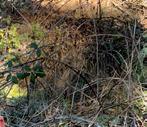

Older dogs know better, so Spradley handles them differently.
“I have a GSP who loves to point but not retrieve, so when this happens I’ll pull her off the next point and move to another covey. If a dog doesn’t want to stand on a covey, or hold when I’m shooting, I’ll make the dog hold steady. Then I’ll walk into a covey, flush it and intentionally shoot and miss, watching my dog to make sure it holds steady. This lets the dog know I’m serious.”

WHEN YOU’RE HUNTING IT can be hard to set down the gun and correct your dog. But remember, a quick fix while in the field can make a huge difference in how your dog performs and will set the tone for the rest of the season. After all, if you don’t let the dog know of your expectations, how else will it learn? CS
Editor’s note: Scott Haugen is a full-time writer. See his puppy training videos and learn more about his many books at scotthaugen.com and follow him on Instagram and Facebook.



Our Desert Eagle grips have undergone a redesign with improvements that are second to none. First we removed almost 1/8 inch from the thickness of each grip. Then we enlarged the radius on the back edge of the grip to reduce the overall circumference. And finally, we eliminated the need for two screws as well as the plastic insert that tra ditionally is needed for mounting the grips. Excellence in design and function, that is the goal of AlumaGrips.

Black Hills Ammunition’s 10mm HoneyBad ger has deep flutes designed for optimum terminal performance without reliance on hollow points. The bullet penetrates deeply, cutting through bone and muscle to get to vitals. This is important when relying on your handgun for protection, including the possibility of bear attack. This is a solid choice for defense!


At Western Range Camps, we specialize in the design, manufacture and sale of the highest quality rangecamps, sheep camps, sheep wagons, commissaries, toy haulers and teardrop trailers. Handcrafted and built to last!
exquisiteknives.com
Random Knives of Argenti na made this kitchen knife for exquisiteknives.com. Random is two young bladesmiths with very creative minds. I have sold a number of their fine piec es. Priced right and very well thought-out designs and execu tion. Exquisiteknives has offered some of the world’s finest custom knives to both users and collectors for over 30 years.

davistent.com/product/ sleeping-bag-cover
Our sleeping bag cover is a great way to protect your sleeping bag and add a little warmth. You can even sleep under the stars on a starry night! Roll your sleeping bag, pillow and sleeping pad up and it’s a perfect bedroll to keep all your sleeping gear organized.

vaultprousa.com
Handgun Pro II standard features:

• American-made handgun safe – factory direct


• Superior-strength handgun safe

• 10-, 7- or 3-gauge steel body models

• S&G D-Drive digital lock
• Auto easy-open system with gas shock
• Military-grade PE foam insert
• Holds two handguns plus magazines and ammunition
• Bolt-down capability
lymanproducts.com

The Lyman Ultimate Reloading System is the only kit you’ll ever need! Outfit an entire reloading bench with premium products designed to accomplish all steps in the reloading process. No other kit from any competitor can match this untouchable value! The Ultimate Reloading System includes top-of-the-line tools and accesso ries like our All American 8 turret press, Gen 6 Digital Powder System, Universal Case Trimmer, Pro 1200 Turbo Tumbler, and everything else needed to turn out high-quality rounds fast! Take your passion to the next level with the Lyman Ulti mate Reloading System!

leelock.com
The Crab Cracker allows you to measure your Dungeness crabs to determine which ones are legal to keep, and then crack them in half over the top of a 5-gallon bucket, thereby separating the two clusters from the shell and guts. Crabs cleaned this way take up half as much space as whole crabs, so you can cook twice as many in your kettle. The Crab Cracker has four different measurements to cover minimum sizes for Oregon, Washington, California, Alaska and Canada. It’s made from solid anodized aluminum, and greatly aids in cleaning Dungeness crabs.





















northriveroutfitting.com
We offer hunts of unmatched quality. Alberta whitetail, moose, caribou and goat. When you join us on a hunt in this spectacular and remote part of British Columbia, you will feel at home and welcomed into our hunting family. That same care, hard work and at tention to detail goes into everything we do.
sagecanyonoutfitters.com
Great Christmas gift for the hunter or hunters in your life. Twenty mixed nonguided bird hunts with up to four guns – $700. Includes ranch access fees, an $800 value. Add a guide for $200.

Join Captain Steve Talmadge and his crew for a safe and exhilarating time shark and deep sea fishing out on the San Francisco Bay waters. Flash Sport Fishing Charters is one of the top fishing charters in San Fran cisco, offering exceptional fishing trips and tours to anglers of all skill levels.
They offer several half-day and full-day guided charter and trip options. Just bring your fishing license and a meal – everything else is included!
Fully insured in California and equipped with a U.S. Coast Guard Masters License. Check out their rates and charter avail ability on their website.

highadventureranch.com

High Adventure Ranch, the oldest big game hunting ranch in Missouri, was founded by Charles Puff in 1983. The ranch has over 30 big game species, with an estimated 2,000 animals. Our guides have over 70 years of experience.
The ranch offers lodging, home-cooked meals, and full-service meat processing.


cawsf.org
California Wild Sheep Foundation is dedicated to putting and keeping wild sheep on the mountains by enhancing their environment with water installations and researching diseases, so that future generations may enjoy the majesty of the iconic California bighorn. Join us today and be a part of the future of wild sheep!
reliablefishing.com
freedommeatlockers.com


Skirt steak, tri-tip, chicken and more! National and state award-winning family-owned and -operated butcher shop since 1972. Specializing in custom cutting, smoked meat and retail meat sales. Award-winning smoked meats, including, 30 varieties of sausages, all made in-house, plus bacon. We have been awarded Best Ham in the United States!
Reliable Fishing Products was established in 2003 and makes the best cooler bags in the industry. They offer 10 bag sizes ranging from 18”x36” to 42”x90”, three kayak bags and three billfish/tournament blankets. They hold ice for days, are collapsible, soft-sided and have a drain plug at the bottom corner.
to bottom corner.
We carry only the best steaks for our customers. We offer high choice-grade beef. We have a full deli on the premise that will make your mouth water!
We pride ourselves in unique marinades on skirt steak, tri-tip and chicken! No order is too small or too large!

https://www.unitedcountrynw.com/search/wa/land-nearwhite-salmon-for-sale-in-goldendale-washington/987692/


Gorgeous land near White Salmon River in Goldendale, Washington for sale. Just a few hours’ drive from Portland/Seattle/Walla Walla. The No. 1 best-kept real estate secret in the Pacific Northwest. Affordable 50-plus-acre lot where nature lovers can unplug and enjoy recreational activities including fishing, hiking, rafting and riding horses, along with stargazing, birdwatching and quail hunting.
https://www.unitedcountrynw.com/search/wa/ corner-riverfront-lot-next-to-cowlitz-riverfor-sale/1076257/
Corner riverfront lot next to Cowlitz River for sale!
Incredible corner lot next to western Wash ington’s Cowlitz River. At 0.5 acre, this is the ideal building parcel at an affordable price. Septic en gineering is complete with Cowlitz County! Power and city water at the property. Minutes to Castle Rock, close to nature and the water.




Picture the scene. You’re in Montezuma Slough; or at the Power Lines on the Sacramento River; or the Firing Line in Suisun Bay; or any one of a thousand other striper haunts in Suisun Bay, the lower Delta or the central Delta.

With Thanksgiving right around the corner and the hills already starting to green up from recent rains, the heat of summer has given way to chilly mornings and mild afternoons. The water temperature is hovering at 57 degrees and mist hangs over the surface. As is often the case in the late fall, there is almost zero wind in the forecast and you’ll be able to fish both the top of the incoming tide early and the beginning of the outgo right after lunch.
Cruising along slowly with your eyes locked on the sonar unit, you watch the bottom. As you navigate a deep hole and track the bottom coming up, you observe a series of arches scattered from 10 to 18 feet deep. They are right near the bottom on the upward slope of the hole.
“Let’s set up here,” you tell your partner, and he scrambles up to the bow and readies the anchor.
You come around and the anchor goes into the water. The boat drifts back and in a few moments, you are sitting steady in 6 feet of water with the edge of the deep hole 100 feet off
the back of the boat.
You and your partner bait up two sliding-sinker-rigged rods with fileted shad, toss them out and set them in balancers with the clickers on and the reels out of gear.
Minutes pass and you both sip coffee as the level of expectation grows. Suddenly your partner’s rod dips down, pops up, dips again and stays down. A beat later the line starts screaming out of the reel against the light resistance of the clicker. You both jump to your feet. Yes! The bite is on.
Golden State striper fishing is such a multifaceted sport. In the Delta you can troll, plug, jig or soak live or dead bait for them. During the spring and summer, you can drift live bait in San Francisco Bay and along coastal beaches, or you can hike the beaches with a surf rod and look for bass blitzing bait. When you find them, you’ll toss big plugs and spoons into the fray.
I’ve battled stripers using all these methods and more. Heck, I even hooked a 15-pounder once drifting roe for kings way up by Red Bluff, but my all-time favorite way to target
them is bait fishing in the Delta.

Call me old school, but I enjoy sitting on anchor in a Delta backwater on a crisp late-fall or early-winter day, listening to the radio and watching the ducks and other wildlife as I wait for that first twitch of the rod that signals the start of a bite.
My dad was a union carpenter for 35 years and he had a saying about cutting a long straight line with a hand saw. “It’s simple but it ain’t easy until you get the hang of it,” he’d laugh.
Well, that’s a good description of bait fishing for stripers. It’s simple, but there is a learning curve. That’s why about 20 percent of Delta bait anglers catch 90-plus percent of the stripers!

If you’d like to be a 20-percenter, keep on reading. I didn’t invent anything I’m about to share, but I had the opportunity to learn the ropes from the late great Capt. Barry Canavero, one of the godfathers of Delta bait fishing.
One mistake anglers often make is working water that is too deep. Sure, stripers hold in deep holes and sometimes you can get them deep, but
if you come across a bass in shallow water – say, 8 feet deep or less – that fish is likely looking to feed.
I like to look for stripers in a couple different basic areas. When I’m out scouting for bass, I try to locate fish holding in deep to medium-deep water and then set up in shallow water adjacent to the fish I mark.
You’re looking for multiple arches holding on or near the bottom. Fish cruising the middle of the water column may or may not be stripers, but it’s fish holding along the bottom that are likely going to feed.
When it’s time to anchor don’t forget the current. The bass will move out of the hole into shallow feeding areas by swimming into the current. Therefore, you want to be sitting upcurrent of the hole in a position that allows you to drop your bait right along the shallowto-deep transition.
If I know for certain there are stripers in the location I’m fishing, I won’t hesitate to set up in nearshore shallow-water areas whether I spot bass on the sonar or not. I’ve had some of my best fishing while anchored in 5 or 6 feet of water, casting baits into water along tule edges only 2 to 4 feet deep. These are the kind of locations stripers move into when hunting and is often where you’ll encounter the biggest bass.
New Delta anglers are often intimidated by the tides and don’t understand how they affect the fishing. Just know this: The bite is always most intense during the last hour of one tide and the first hour of the next.
Incoming or outgoing doesn’t matter to me. On a good day the stripers will bite throughout the tide, but the most intense action will be when a tidal cycle starts or ends, so at that time it’s important to be anchored and fishing, not cruising around looking for fish.
A lot of rod-and-reel combos will work for bait fishing, but for the best results you want a 7- to 8-foot fastaction rod with a sensitive tip. The

rod should be able to handle weights up to 3 ounces.
Top your rod with a conventional reel equipped with a clicker. Most guys are running with 30- to 50-pound braid these days, but 12- to 15-pound copolymer still works very well. Stripers, even big fish, don’t make long runs, so 175 to 200 yards of line capacity is ample.
Once you thread the main line through the rod’s eyes, slip on a sliding sinker sleeve, then a bead and finally use a Palomar knot to attach a snap swivel. Your leader should be constructed of 25-pound copolymer and tipped with either a 9/0 octopus hook or a No. 4 treble, depending on the bait being used. We’ll talk more about that in a moment.
Few anglers think much about what style of sinker they use, but for my money a flat river sinker works best. They don’t offer much resistance coming through the water, but they lay flat and don’t walk around, so your bait stays put. A small selection of 1-, 2- and 3-ouncers will get the job done.
Stripers eat a long list of prey items,










including marine worms, shrimp, baitfish, bluegill, clams, crawfish and more. Popular striper baits for Delta anglers include threadfin shad, sardines, anchovies, pile worms, bloodworms, grass shrimp, ghost shrimp, mudsuckers, bullheads and jumbo minnows.
Truth be told, I’ve used all these baits at one time or another, but my hands-down most productive baits over the past 25 years have been threadfin shad and bullheads. If I can’t score bullheads, and at times you can’t, mudsuckers are a decent substitute. I feel that bullheads are superior because they tend to live longer and I think big bass prefer bullheads over mudsuckers, but if you can’t get bullheads, by all means grab a few live mudsuckers.
Fresh shad is better than the frozen stuff you find at many bait shops. If you are serious about bait fishing, find a shop that has a source for fresh shad and buy 10 or 15 pounds at once. Brine them using rock salt, ProCure Bluing, ice cubes and water.
Create a slushy blue brine and let your baits soak in it for about eight hours. Then remove them and bag
them up in ½-pound batches in Ziploc bags. Don’t vacuum pack them since it will smash the baits.

When you go fishing, make a small batch of brine in a small bait cooler and put a bag or two of partially thawed shad into the brine. You’ll want a few packages of backup shad fully frozen in your main cooler in case the fish are biting well.
For your bullheads or mudsuckers you’ll want a plastic minnow bucket rigged with a length of paracord so you can let the baits soak in the river once you anchor. Just remember to haul them in before you speed off. I’ve lost a few nice minnow buckets that way!
For shad you’ll want a leader tipped with a 9/0 hook. Take a nice chrome-bright shad and filet it from head to tail, but don’t detach the filet. Flip the filet 180 degrees so that it is meat side out. This way the bait will put maximum scent into the water.
Pass the hook point through the rear third of the shad and bring it back through behind the shad’s head near the black dot. Finally, half hitch the leader around the shad’s tail twice and you are ready to fish. Simply tie a loop in the top end of the leader and
baited with shad and bullheads sit in rod balancers with the clickers on and the reels out of gear waiting for the bite to begin and the fight to ensue.





snap it onto the snap swivel at the end of your main line.


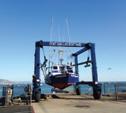

If fishing bullheads and mudsuckers, you’ll need a bait needle and you’ll want a leader tipped with a No. 4 treble. Don’t tie a loop into the leader until the bait is threaded.

To bait up, proceed like this: Take
Big striped bass are a thrill to fight, but smaller fish are better eating, so snap a picture and let the trophies go to reproduce. The fun part with monsters like this is in the catching. (CAL KELLOGG)

a baitfish in your hand and insert the needle gently ½ inch behind the head and slide it just under the skin to a point half an inch short of the tail and then pop it through the skin. Put your leader into the needle and pull it through the bait. Once through, put a loop in the top of the
leader. Slide the leader through the bait until the hook is resting right next to the bait’s head. Rigged this way the bait will stay alive and mobile. If it’s a bullhead, you can usually catch a few fish on it before it gets killed. Fishing mudsuckers, you usually need a new bait for every bass.

Execution is the final piece of the puzzle. Fish with the clicker on and the reel out of gear. Rod balancers are nice for this work. When a bass starts playing with your bait, let the fish have it until the line is streaming off the reel in earnest. Then pick up the rod, engage the reel and find out if the bass is a 24-inch eater or a 24-pound trophy. Fish on! CS
Editor’s note: Cal Kellogg is a longtime Northern California outdoors writer. Subscribe to his YouTube channel Fish Hunt Shoot Productions at youtube.com/ user/KelloggOutdoors.













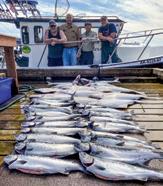



 By Mark Fong
By Mark Fong

After a very hot summer and early fall here in Northern Cal ifornia, as of late October con ditions have finally started to change.
Fall is my favorite season to be on the water, with chilly mornings and warm afternoons not only making for
great sweatshirt-and-shorts weather, but it also means some of the best bass fishing opportunities of the year.
But with California firmly mired in extreme drought conditions, many of my favorite fall fishing destina tions have been negatively impacted by low water levels and limited boat launch facilities.
To the north of Sacramento, Lake Oroville had two operable concrete launch ramps in service, so when I found an open day on my calendar, I wasted little time in extending an invitation to longtime fishing buddy Ian Rigler to join me for a day of fall bass fishing.

When we arrived at the Loafer Creek Boat Launch, there was a chill in the air. High temperatures were forecasted to be in the mid-70s, a wel come relief from the 90-degree temps of the prior week. It had been several months since my last trip to Lake Or oville and the lake was much lower than I anticipated. On this mid-Octo ber day, the lake was over 200 feet be low full pool and continuing to drop.
Fall bass fishing is all about finding the bait, and when you find it the bass won’t be far away. But getting the fish to bite – well, that can be anoth er story altogether. As the fish feed up for the upcoming winter, they gorge themselves on massive schools of bait, making it challenging to fool them into biting an artificial lure when they are surrounded by the real thing.
My game plan for the day was to
run a bunch of spots looking for bait and bass. Once we were on the wa ter, I slowly idled the boat past the 5 mph buoys. In the distance I spotted a school of bass that was pushing bait on the surface.
I quickly put the boat on pad and we made our way toward the commotion. I pulled up short of the school and used the trolling motor to position the boat. I picked up my topwater rod and began casting a walking-style bait, while Ian elected to fish a drop-shot rig.
It wasn’t long before Ian was hooked up with the first bass of the morning. As he brought the fish close to the boat, it spit up a cloud of pond smelt, a sure sign it had been feeding heavily. After a spirited fight and with a big grin on his face, Ian carefully re leased the fish back into the water.
I continued to throw my topwater bait as Ian caught and released several more fish. I didn’t want to miss out on the action, so I decided to switch over to a spinning rod rigged with a small finesse swimbait on a darterhead jig. After about a dozen casts I was hooked up with my first fish, but it did not take me long to realize that this was not the quality of bass we were looking for.
We continued down the bank for
about 200 yards, but all we could muster were a few more small fish. Suddenly the breeze, which had been blowing steadily, died; with it the fish shut down and the bite stopped. It was time to make a run.
We left Oroville’s main body and sped under the Green Bridge in search of better conditions and biting bass. At the split I made a left and headed up the Middle Fork of the Feather River. At the location where the canyon walls start to narrow up I stopped on the outside edge of a steep point and began graphing the area with my electronics. In short order I found a stretch of bank that was loaded with pond smelt.
We fished down the bank for about a quarter of a mile with more of the same – a bunch of small fish but no quality catches. Since we were struggling to find a better bite, we bounced around to half a dozen high percentage areas in the Middle Fork Feather and yet again the re sults – quantity and no quality – were the same. I looked at my watch and was surprised to see that the day was quickly getting away from us. By this point we had caught and released a couple dozen bass, but it was not the action we had hoped for. On the bright side, there was still time in the day to make that happen.
I fired up the big motor and we made the long run down the Feather and under the Bidwell Bar Bridge, where we continued across the main body towards the North Fork Feather. The wind was blowing again and I pulled up on a bluff bank and graphed around until I located a steep edge that was stacked with bait. Ian continued fishing the drop shot and was again first to hook up with a hard-fighting spotted bass. This was a better-quality fish, which gave Ian quite a fight on 6-pound line.
After releasing the fish, Ian quickly hooked another bass. I looked down at my electronics and the graph was lit





up with a school of active fish.


I put down my swimbait gear and made a short cast with my drop-shot rig. With my forward-facing sonar, I watched my drop-shot rig fall toward the school of suspended bass. We were fishing in 70 feet of water and the school was suspended at 45 feet.



Out of the school, a single fish made a beeline towards my bait, and in an instant my rod began to bend and I was hooked up. We experi enced video game fishing at its finest.

This was clearly a better-quali ty participant at the end of my line, and it made a strong run towards the depths. After making several strong runs the fish headed for the surface and I began to think that it was not a bass; for a moment I pondered if I’d hooked up with a freshwater king salmon. But when the fish came into view, it was a big spotty.
When the fish saw the boat, it made another strong run. I carefully worked it close to the boat and when it was within reach, I slid my hand under its belly and lifted it into the boat. I quickly unhooked the bass and returned it to the water. It would be the best fish I’d catch that day.
For the next hour or so I used my for ward-facing sonar to chase the school of bass. We would catch a few good fish from the school and then the bass
would move and scatter, so I would have to relocate them all over again.
At times the action was frantic, as we experienced a number of double hookups. Ian stuck it out fishing a small swimbait on his drop-shot rig, while I alternated between a drop
shot and a jigging spoon.
It’s hard to leave with the bite still on, but facing a long drive home and an early dinner commitment, that is exactly what we had to do. Despite the drought-affected water levels, we had had a productive day. CS













 By Chris Cocoles
By Chris Cocoles
SAN FRANCISCO–I’ve had a lovehate relationship with this metrop olis. I love that my parents grew up there; love that I was born there; love San Francisco’s free spirit and its di versity and its tolerance for inclusion; love some of the great food its restau rants offer.
But I hate trying to navigate some
of its narrow streets; hate how hard it can be to park there and how the traffic wears you down; hate its NFL and MLB teams (I root for rival fran chises!); hate the crowds in the most touristy spots in town whenever I end up there.
So on balance I had a good feeling coming to San Francisco on an ear ly fall Sunday morning. We arrived shortly before 6 a.m. into what we
locals call the “City.” Traffic was a breeze, parking a snap at the nearby garage (despite the hefty price tag). And Fisherman’s Wharf – one of those usual tourist traps – was qui et, peaceful and darn near empty, a sight I’ve rarely experienced.
After having pondered a fishing trip with some family members, we managed to secure a spot on a Fish erman’s Wharf-based boat operated
by Capt. Don Franklin of Soleman Sportfishing (510-703-4148; sole manfishing.com). Franklin and I had collaborated on a San Francisco shark fishing story in 2014, and I knew he was one of the most respected charter boat skippers in the fleet. I figured we were in good hands.
MY BROTHER-IN-LAW ALAN KING and his son-in-law David Laver joined us on our shared half-day charter. Shortly after we arrived and made our way down a ladder onto Franklin’s 32-foot Uniflite boat, the other two members of our party, local San Francisco resi dents Marcus and Emilia, came aboard. After a quick briefing by Franklin – we would head out of the bay to seek rock fish after he pondered targeting halibut – we stopped at the marina bait station to load up on sardines and off we went.
Looking back as the sky turned from dark to daylight, I could see a lit-up Coit Tower and the downtown skyline. In the other direction we


spied Alcatraz Island and then sped out towards the Golden Gate Bridge.

I actually don’t recall ever travel ing by boat under the iconic span of the Golden Gate. So while the chilled air kept much of our group crowd ed into the cabin with Franklin and his deckhand for the day, Ty Harris, I opted to brave the elements as we cleared the bottom of the bridge and hit the Pacific Ocean.
The trip took about an hour and Franklin’s speakers belted out his Beatles playlist. So as we checked out the scenery, we were serenaded by “Strawberry Fields,” “Penny Lane,” “Hey Jude” and other Fab Four hits. Franklin pointed out a couple land marks, in particular explaining the lighthouse (and replica Golden Gate Bridge) at Point Bonitas, which has guided ships in and out of San Fran cisco Bay since 1855.
I struck up a conversation with deckhand Harris, who was filling in with Franklin for the first time but
spends a lot of time working with fellow San Francisco-based charter service Flash Sportfishing. Harris, a diehard bass angler and tournament participant, lives in Escalon in the San Joaquin Valley and often when he has multiple shifts will sleep on another iconic San Francisco boat, the Lovely Martha, which Franklin also worked on years ago when he was trying to break into the business.
The clouds never broke away into the sun until we arrived back at Fish erman’s Wharf, but by the time we stopped just off the beach town of Bolinas in Marin County, the water was relatively calm – for most of us onboard – and the weather pleasant. It was time to try our luck.
TWO MOMENTS EARLY ON in our morning convinced me that our captain knew these waters well, and furthermore, that he was respected among his fel low fishermen, having run his boat for just over 20 years now.

As we were slowing down in an ticipation of getting lines in the wa ter, Franklin was chatting up anoth er boat in the area and providing his location, a point of interest he called “Soleman’s Rock.”
“I can’t believe this guy has a spot named after him. Wow,” I told myself. Later in the morning during some down time I asked Franklin about the origins of Soleman Rock. Simple. One of his fellow captains named it after him. Nothing more. Nothing less.
At one point, one of those other boats drifted by and exchanged pleas antries and updates. As they headed up the coast someone shouted, “We love you, Soleman!”
“For me, it was a thing where I used to go out on charter boats with my dad. And eventually it came full circle in that not only were the guys I knew and went out on their boats, I became a peer and a cowork er of theirs once I got my own boat,”
Franklin would tell me a few days later in a phone interview. “So it was like all the guys I grew up idolizing, now I’m working with them.”
The rest of us in the boat felt that love too with all the action the rock fish provided us. At times it was a

dizzying, chaotic and wonderful hot mess of strikes as we reeled up a col orful cavalcade of black, vermillion and canary rockfish.
This was the simplistic yet ac tion-filled fishing of my dreams. We all took our places at various sections of the vessel – I manned the stern – and as Capt. Don and deckhand Ty instructed, dropped our weight ed-down jigs and baitfish to the bot tom while fishing in water anywhere from 70 to 100 feet deep.


When our line hit the ocean floor, we’d reel up a few cranks and then jig the rod up and down. Most of the time it was mere seconds before our rod tips would bend. There was no need to set the hook, just reel quick ly and anticipate what was on the other end. As it turned out, the port side of the boat, where my family members Alan and David were fish ing, was on fire.
I’d look back seemingly every few seconds after regularly hearing “Fish on,” with Franklin or Harris scram bling to help pull in either perfect eating-sized rocks, smaller ones not worth keeping or tiny specimens that made for perfect lingcod bait. On the starboard end Marcus and Emilia were also scoring some nice catch es, while I had a steady number of bites and more than a few keepers. My highlight was hitting a double of
Our remote Alaskan fishing lodge is situated on the upper stretches of the beautiful Egegik River. You’ll watch some of Alaska’s most stunning sunrises, complete with a distant, active volcano. We are a fishing camp specializing in coho fishing, brown bear viewing, and flyout fishing adventures to even more remote destinations in the Last Frontier.




The Egegik River is touted by many experienced anglers as the best silver salmon stream in all of Alaska. Becharof Lodge On The Egegik River was the first fishing lodge to become established on the breathtaking Egegik River, and is less than a 5 minute boat ride from some of the best fishing holes on the entire river.




Included in your fishing trip:
• 5 days fishing/5 nights stay in camp
• Experienced, fully guided fishing.
• Comfortable cabins furnished with beds, cozy comforters & bedding.
• Home cooked meals, snacks, and nonalcoholic beverages.
• Transportation from the lodge to prime fishing holes on the Egegik River.
• Freezing and vacuum sealing of your fish, up to 50 lbs., per angler.
Deckhand Ty Harris shows off the editor’s double on vermillion rockfish. Capt. Don Franklin put all of his clients on plenty of keeper fish to take home.


feisty vermillions that would eventu ally be a great meal I had with some friends later in the week.
About the lings: We kept hoping for one of those behemoths to swal low our smaller rockfish on the way up. More than a few times our crew was convinced a bigger lingcod was hooked up, only to slip away.



In all, our boat managed to bring up three lingcod, including one by David that was just big enough to surpass the 22-inch minimum length. Marcus also landed a ling, but after a quick photo he had to release his after it came short when we measured it.
About the only downer of the morning was that Emilia got a little queasy. But after resting in the cabin for a while, she was our charter’s MVP when she came back out and scored not only some nice rockfish for her and Marcus to take home, but the sec ond keeper lingcod of the morning.

Even at our worst our group man aged to have the best time.
ON THE JOURNEY BACK to the dock, Ty fi leted our limits (David grilled up some of our haul that night back at Alan’s house in San Mateo with the rest of the family). The sun broke out as we approached the Golden Gate Bridge again, play-by-play updates from NFL games broadcasting on Frank lin’s speakers. Back at the dock, we grabbed our cooler and baggies stuffed with filets, settled up the bill and then headed up the ladder.
Midday at Fisherman’s Wharf was quite a contrast and a reminder of my love-hate relationship with San Fran cisco. The quiet and peace I’d encoun tered early that morning was now a cir cus of tourists clogging the streets.
But as tired as my arms and legs were and in a rush to get back home to catch the end of the Sunday after noon football games, I was happy to be a part of this mayhem. CS
Editor’s note: Next month, we’ll have a story on Soleman Sportfishing skipper Don Franklin’s work with local kids in the San Francisco Bay Area.






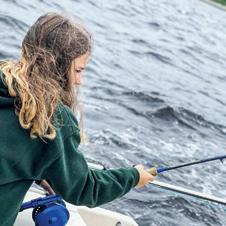






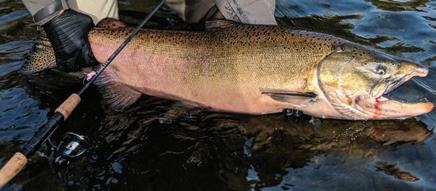

With all the great fishing going on right now, choosing what to chase can be hard. But weather can change in an instant, or sometimes your schedule doesn’t permit an all-day tuna trip, yet you still need to have a tug on your line and catch some fish.
Bay bass fishing can be that outlet for you, especially with San Diego’s Mission Bay on a red-hot bite right now. There is a ton of bait and the bass and other species are attacking lures.

With five different launch ramps, it’s easy to get in and out of the water quickly and back to that appointment you may have. Check the tides; as long as there is moving water, you should catch fish.
The types of fishing you can do in Mission Bay are endless. There are a lot of docks to flip, along with rocky shorelines, sandy beaches and weedbeds that go on forever. On a recent outing to the bay, we found that the bass were really schooled up in the thicker weeds. Watch for the weedbeds on your meter and fish those areas thoroughly.
Freshwater techniques really work well in this bay. Light tackle, spinning gear or casting gear will do the trick; think a 6½- to 7½-foot rod with braid
and a fluorocarbon leader. I like my Daiwa Back Bay setups for the two bays I fish most.
For jigheads, ¼ ounce is all you will need most of the time, as most of the bay is only 10 to 12 feet deep. A straight jighead or underspin will do well with your choice of a 3- to 3½inch swimbait or grub.

For colors, experiment with different paint schemes and size tails, but variations with chartreuse are a favorite of many Mission Bay anglers. Big Hammer’s City Shrimp can do well, as will tails from MC Swimbaits, Reyes Swimbaits and Yamamoto. But experimenting is half the fun.
Don’t leave your crankbaits at home either; they do work well in this bay
for the bass. I like floating ones better than neutrally buoyant plugs as, on the pause of your crank, they will float up in an erratic motion. Nine times out of 10 you will be bit on the pause or just as you start up winding again. It takes a little practice to learn to bring the bait in just above the weeds, but once you get it, the fish will bite hard.
The hard jerkbait, a cousin of crankbaits, will also do well in the bays, as it looks almost exactly like an anchovy if you get it in silver with a black back. It can be red-hot at times. It also takes practice to work well, but once you get it down the bass will come, as will halibut and shortfin corvina.
The soft jerkbait will also do well over thick weedbeds when the tide is
up. Its random floating and darting action drives the bass nuts and coaxes them into biting it.
Spinnerbaits are another favorite of Mission Bay bay bass anglers. As previously mentioned, the bay is full of giant weedbeds and a spinnerbait run just over the top of the weeds can attract some giant spotted bay bass. Willow or Colorado blades will work well, and I actually run a large willow and small Colorado blades on my favorite spinnerbaits. You might want to even build your own and experiment. There’s nothing like catching a bass on a lure you have built.
One of the lures that has been redhot lately is the umbrella rig. I use the


Yumbrella rig and along with the baits it has small spinnerbait willow blades that add to the illusion of a small group of anchovy swimming along. For Mission Bay, you will definitely want to keep the weight of your jigheads down to 1/8 or ¼ ounce, because you want to stay out of the weeds.
Tails are usually the standard 3- to 3½-inch swimbaits, but some anglers will dress them with curl-tail grubs. This rig in 10 to 12 feet of water must
be retrieved perfectly over the weeds, but if done correctly you will score some giant spotties.
Finally, let’s talk about flipping. Attacking the docks and their pilings can be a lot of fun and produce giant bass. Don’t forget that Paul Weintraub’s IGFA-record spotty came from Mission Bay and weighed in at a whopping 4 pounds 15 ounces.

And Paul was flipping docks from his kayak.
You may want to go a bit heavier in line size; some anglers feel that you should also go up in lure size. I like to use the lightest jighead I can get away with and still get it to the bottom. The slow fluttering sink of the bait, I feel, attracts more bites.
A couple of other ways to have fun in Mission Bay is to micro-fish; that is, fish with small trout gear. Use 2- to 6-pound-test line, crappie jigs and grubs or micro cranks. For bait, use a small jighead, 1/64 to 1/8 ounce, and bait it with bloodworms or ghost shrimp. You will catch everything from sand dabs to croaker and maybe even an occasional bonefish.
The other way to have fun out here is at to the other end of the fishing spectrum: bat rays and sharks. From shore or boat they can test both you and your gear. Use heavy tackle, such as a heavy bait stick with a reel that can hold 25- to 40-pound test, and throw a half to a whole 1-pound mackerel. The bat rays in the bay reach 125 pounds easily and have wingspans of up to 6 feet. When you hook one of these, it’s a fight two or three fishermen can share. They just don’t give up!

Sharks of various shapes and sizes frequent the bay as well and will eat the same bait.
Mission Bay Park is like a giant lake and you can almost fish it like one. The center of the bay and main area has no speed limit and can get crazy in the summer, and there is a section of Sail Bay and a small bay behind Fiesta Island that has water skiing and is marked with sign. But the rest of the entire bay is limited to speeds up to 5 mph, or a no-wake speed limit. Early mornings are usually quiet and you can explore a lot more area, but as the crowd grows, be careful of all the boats and jet skis as you’re enjoying the hot bite. CS

